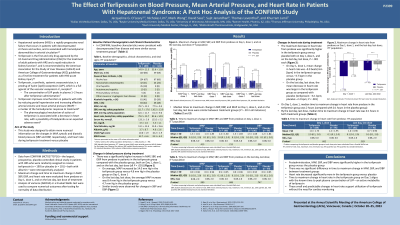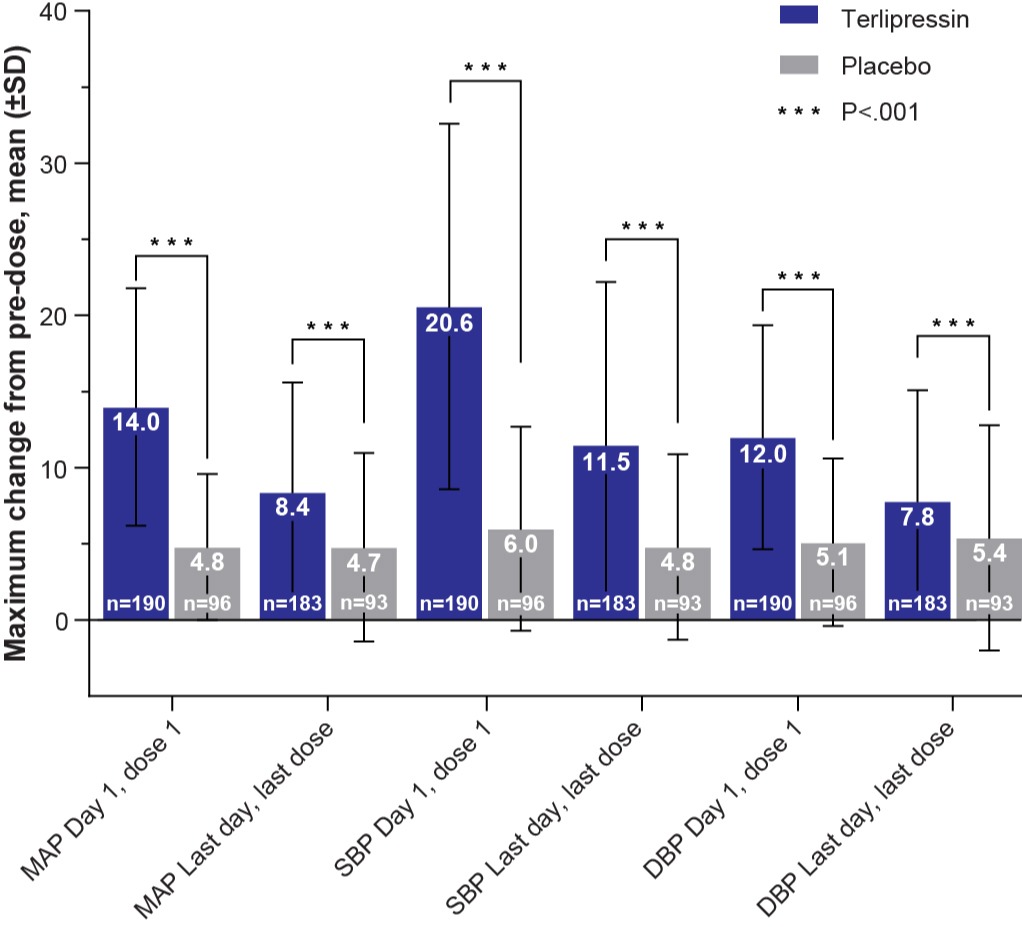Monday Poster Session
Category: Liver
P2399 - The Effect of Terlipressin on Blood Pressure, Mean Arterial Pressure, and Heart Rate in Patients with Hepatorenal Syndrome: A Post Hoc Analysis of the CONFIRM Study
Monday, October 23, 2023
10:30 AM - 4:15 PM PT
Location: Exhibit Hall

Has Audio
- JO
Jacqueline G. O’Leary, MD
Dallas VA Medical Center & Baylor University Medical Center
Dallas, TX
Presenting Author(s)
Jacqueline G. O’Leary, MD1, Nicholas Lim, MBBCh2, Mark Wong, MD3, David Sass, MD4, Sujit Janardhan, MD, PhD5, Thomas M. Leventhal, MD6, Khurram Jamil, MD7
1Dallas VA Medical Center & Baylor University Medical Center, Dallas, TX; 2University of Minnesota Medical School, Minneapolis, MN; 3Banner Health, Phoenix, AZ; 4Thomas Jefferson University, Philadelphia, PA; 5Rush University Medical Center, Chicago, IL; 6University of Minnesota, Minneapolis, MN; 7Mallinckrodt Pharmaceuticals, Bridgewater, NJ
Introduction: Hepatorenal syndrome (HRS), a rapidly progressive renal failure, occurs in patients (pts) with decompensated cirrhosis and ascites, and is associated with hemodynamic abnormalities in arterial circulation. Terlipressin (Terli) is a prodrug of lysine-vasopressin (LVP), the concentration of which peaks in plasma 60–120 min after Terli administration. Terli improves renal function in pts with HRS by reducing portal hypertension and increasing effective arterial volume and mean arterial pressure (MAP)—a marker of the hemodynamic response to treatment. A more nuanced insight into changes in MAP, heart rate (HR), and systolic and diastolic blood pressure (SBP and DBP, respectively) during Terli treatment is of interest.
Methods: Data from CONFIRM (NCT02770716)—the largest, prospective, placebo (Pbo)-controlled, clinical study in pts with HRS who were randomly assigned to receive Terli (n=199) or Pbo (n=101), both with albumin—were retrospectively analyzed. Maximum change and time of maximum change in MAP, SBP, DBP, and HR were evaluated from pre-dose to Day 1, dose 1, and to the last day, last dose of treatment. Data were analyzed using a Kruskal-Wallis test or ANOVA after testing for normality.
Results: In CONFIRM, mean MELD score was 32.8 and mean serum creatinine was 3.5 mg/dL at baseline. The maximum decrease in HR was higher in the Terli group vs Pbo at Day 1, dose 1 (mean change [SD] Terli -9.9 [8.0] beats/min [bpm]; Pbo -3.7 [5.3] bpm, P< .001) and at last day, last dose (mean [SD] Terli -6.1 [7.0] bpm; Pbo -2.2 [2.8], P< .001). Median time to the maximum change in HR at Day 1, dose 1 was 120 min in the Terli group and 6 min in the Pbo group (P=.062).
There was a significantly higher increase in MAP, SBP, and DBP from predose in pts in the Terli group than in the Pbo group, both at Day 1, dose 1 and the last day, last dose (Figure); while median time to the maximum change at Day 1, dose 1 was similar between treatment groups (P>.20 in all instances).
Discussion: Postadministration, HR decreased significantly more, while MAP, SBP, and DBP increased significantly more in the Terli group vs Pbo group. The time to maximum change in HR in the Terli group aligns with the known time to peak plasma concentration of LVP—an active metabolite of Terli. However, there was no significant difference in time to maximum change in MAP, SBP, and DBP between treatment groups. These small and predictable changes support utilization of Terli without the need for cardiac monitoring.

Disclosures:
Jacqueline G. O’Leary, MD1, Nicholas Lim, MBBCh2, Mark Wong, MD3, David Sass, MD4, Sujit Janardhan, MD, PhD5, Thomas M. Leventhal, MD6, Khurram Jamil, MD7. P2399 - The Effect of Terlipressin on Blood Pressure, Mean Arterial Pressure, and Heart Rate in Patients with Hepatorenal Syndrome: A Post Hoc Analysis of the CONFIRM Study, ACG 2023 Annual Scientific Meeting Abstracts. Vancouver, BC, Canada: American College of Gastroenterology.
1Dallas VA Medical Center & Baylor University Medical Center, Dallas, TX; 2University of Minnesota Medical School, Minneapolis, MN; 3Banner Health, Phoenix, AZ; 4Thomas Jefferson University, Philadelphia, PA; 5Rush University Medical Center, Chicago, IL; 6University of Minnesota, Minneapolis, MN; 7Mallinckrodt Pharmaceuticals, Bridgewater, NJ
Introduction: Hepatorenal syndrome (HRS), a rapidly progressive renal failure, occurs in patients (pts) with decompensated cirrhosis and ascites, and is associated with hemodynamic abnormalities in arterial circulation. Terlipressin (Terli) is a prodrug of lysine-vasopressin (LVP), the concentration of which peaks in plasma 60–120 min after Terli administration. Terli improves renal function in pts with HRS by reducing portal hypertension and increasing effective arterial volume and mean arterial pressure (MAP)—a marker of the hemodynamic response to treatment. A more nuanced insight into changes in MAP, heart rate (HR), and systolic and diastolic blood pressure (SBP and DBP, respectively) during Terli treatment is of interest.
Methods: Data from CONFIRM (NCT02770716)—the largest, prospective, placebo (Pbo)-controlled, clinical study in pts with HRS who were randomly assigned to receive Terli (n=199) or Pbo (n=101), both with albumin—were retrospectively analyzed. Maximum change and time of maximum change in MAP, SBP, DBP, and HR were evaluated from pre-dose to Day 1, dose 1, and to the last day, last dose of treatment. Data were analyzed using a Kruskal-Wallis test or ANOVA after testing for normality.
Results: In CONFIRM, mean MELD score was 32.8 and mean serum creatinine was 3.5 mg/dL at baseline. The maximum decrease in HR was higher in the Terli group vs Pbo at Day 1, dose 1 (mean change [SD] Terli -9.9 [8.0] beats/min [bpm]; Pbo -3.7 [5.3] bpm, P< .001) and at last day, last dose (mean [SD] Terli -6.1 [7.0] bpm; Pbo -2.2 [2.8], P< .001). Median time to the maximum change in HR at Day 1, dose 1 was 120 min in the Terli group and 6 min in the Pbo group (P=.062).
There was a significantly higher increase in MAP, SBP, and DBP from predose in pts in the Terli group than in the Pbo group, both at Day 1, dose 1 and the last day, last dose (Figure); while median time to the maximum change at Day 1, dose 1 was similar between treatment groups (P>.20 in all instances).
Discussion: Postadministration, HR decreased significantly more, while MAP, SBP, and DBP increased significantly more in the Terli group vs Pbo group. The time to maximum change in HR in the Terli group aligns with the known time to peak plasma concentration of LVP—an active metabolite of Terli. However, there was no significant difference in time to maximum change in MAP, SBP, and DBP between treatment groups. These small and predictable changes support utilization of Terli without the need for cardiac monitoring.

Figure: Figure. Maximum change in MAP, SBP, and DBP from predose to Day 1, dose 1 and to last day, last dose; intent-to-treat population.
DBP, diastolic blood pressure; MAP, mean arterial pressure; SBP, systolic blood pressure; SD, standard deviation.
DBP, diastolic blood pressure; MAP, mean arterial pressure; SBP, systolic blood pressure; SD, standard deviation.
Disclosures:
Jacqueline O’Leary: Genfit – Consultant. Grifols – Consultant. Mallinckrodt Pharmaceuticals – Consultant.
Nicholas Lim indicated no relevant financial relationships.
Mark Wong indicated no relevant financial relationships.
David Sass indicated no relevant financial relationships.
Sujit Janardhan indicated no relevant financial relationships.
Thomas Leventhal indicated no relevant financial relationships.
Khurram Jamil: Mallinckrodt Pharmaceuticals – Employee.
Jacqueline G. O’Leary, MD1, Nicholas Lim, MBBCh2, Mark Wong, MD3, David Sass, MD4, Sujit Janardhan, MD, PhD5, Thomas M. Leventhal, MD6, Khurram Jamil, MD7. P2399 - The Effect of Terlipressin on Blood Pressure, Mean Arterial Pressure, and Heart Rate in Patients with Hepatorenal Syndrome: A Post Hoc Analysis of the CONFIRM Study, ACG 2023 Annual Scientific Meeting Abstracts. Vancouver, BC, Canada: American College of Gastroenterology.
